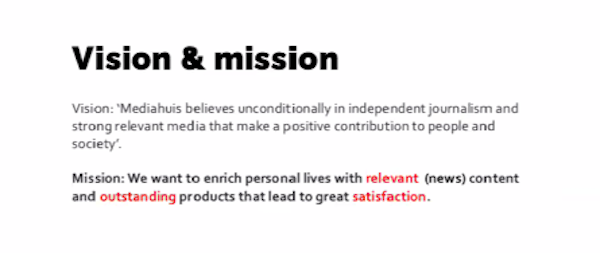
Pretty much all newsrooms now use audience data. Most look at how their content performs, tracking page views, website visits and where the traffic is coming from.
But what sets successful newsrooms apart is that they do not use data to merely track content but to better understand their audience. Listening to their users helps them discover their needs and then tailor the news products and services to make the audience happy.
"Users are telling us so much," said Riske Betten, digital director at Mediahuis in the Netherlands, speaking at the INMA Audience Analytics Town Hall event yesterday.
"And if you don’t listen to your customer, someone else will."
Switching from content-centric to user-centric takes some getting used to and for most journalists, this is unfamiliar territory. Newsrooms already struggle with using data to make editorial decisions, let alone doing audience research and listening to their readers to understand their needs and pain points.
"If you think you know your customers without listening to them, you are wrong," continued Betten, adding that focusing on what your competitors are doing rather than on what your own users need will take you on the wrong path.
Tell a story
If you want to start or improve the way your newsroom uses metrics, focus on communication: the secret to helping journalists embrace data is to use it to tell a story. Just throwing numbers at your colleagues does not guarantee they will use them. So, for instance, rather than saying "we hit 1 million page views this month", explain to your team what this means and why it matters. Treat your colleagues like your readers and make the story interesting and relevant to them.
Another way is to spark journalists' natural curiosity and get them to ask "why is XYZ happening?," according to Enrique Gómez, COO at Grupo AM, who also spoke at the event. His company built three tools that helped journalists warm up to data: easy-to-understand weekly reports, a playbook to run A/B tests, and live dashboards to understand user behaviour. Having a live dashboard also helps you get the newsroom talking about why the metrics matter since you can treat the latest data like breaking news.
Do your research
The best way to know what your users think is to ask them. And it does not need to be a full-on questionnaire, simplicity is often the best choice.
Gomez swears by net promoter score (NPS), a two-question survey that asks your readers 'from 0-10, how likely are you to recommend this product or service to your friend or relative?', followed by one or two questions. If they answer anything under eight, you ask what it would take to get to 10. And if they answer nine or 10, you ask what their favourite thing about the product is.
This is particularly useful to get to users' most significant pain points and also to learn why they love your product.
Learn through trial and error
If data could tell you what the right solution is, life would be simple. But it does not, so you need to use information about your users to come up with hypotheses and test them to see whether you are right.
For instance, if you have a data-informed hunch that investigative stories would attract more readers if published on Saturday morning, start doing just that for a period of, say, three months and see whether you are right. If not, look at what the fresh data tells you and try something else.
You can also try A/B testing, a method often used for creating newsletter subject lines. This tool allows you to test one version of a product (say a headline) for one group of users and compare that to another group of users who see a different version. This way, you can determine which one is more successful. The basic structure for forming a hypothesis, according to Gómez, is "If…, then…., because."
Set goals
To understand where you are going with this, you need a destination. Ideally, your company has a vision and mission statement that tell you and your users what you are trying to achieve. Do not get put off by the business jargon - a vision statement is basically a sentence that sums up your company values and a mission statement outlines what you do to put those values into practice.

In the example of Mediahuis, goals become immediately clear from the mission statement: producing relevant content, creating outstanding products and having satisfied subscribers. Your goals may be similar or different, what is important is that you have a clear sense of what you are striving for and work backwards on how to achieve that.
Start small and focus on easy wins
Beware of getting lost in endless infrastructural projects and taking on too much work at once. You do not even need to have a full strategy in place to start making changes and if you do have it all planned out, break it down into small steps. The best idea is to focus on solving single small problems and tackle what you can directly influence. It is also okay to ask for help if you or your team lack a particular skill, or outsource some tasks altogether.
After all, what matters is that you end up with a product that makes your users happy and that you can be proud of.
Free daily newsletter
If you like our news and feature articles, you can sign up to receive our free daily (Mon-Fri) email newsletter (mobile friendly).
Related articles
- Meet the media innovator breaking down barriers between Polish and Ukrainian women
- How The Economist reached young audiences through new formats and brand marketing
- Five media sustainability lessons from The Economist
- RISJ Digital News Report 2024: User needs with Vogue and The Conversation
- Video meets podcast: Five tips for making a successful 'vodcast'









